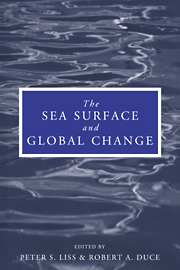Book contents
- Frontmatter
- Contents
- List of contributors
- Preface
- 1 Report Group 1 – Physical processes in the microlayer and the air–sea exchange of trace gases
- 2 Report Group 2 – Biological effects of chemical and radiative change in the sea surface
- 3 Report Group 3 – Photochemistry in the sea-surface microlayer
- 4 Transport processes in the sea-surface microlayer
- 5 The role of organic films in air–sea gas exchange
- 6 Bubbles and their role in gas exchange
- 7 The physical chemistry of air–sea gas exchange
- 8 The sea-surface microlayer and its effect on global air–sea gas transfer
- 9 Chemistry of the sea-surface microlayer
- 10 Biophysics of the surface film of aquatic ecosystems
- 11 Biological effects of chemicals in the sea-surface microlayer
- 12 Neuston of seas and oceans
- 13 Photochemistry in the sea-surface microlayer
- 14 Hydrocarbon breakdown in the sea-surface microlayer
- 15 Applications of laser technology and laser spectroscopy in studies of the ocean microlayer
- 16 Remote sensing of the sea-surface microlayer
- Index
10 - Biophysics of the surface film of aquatic ecosystems
Published online by Cambridge University Press: 24 September 2009
- Frontmatter
- Contents
- List of contributors
- Preface
- 1 Report Group 1 – Physical processes in the microlayer and the air–sea exchange of trace gases
- 2 Report Group 2 – Biological effects of chemical and radiative change in the sea surface
- 3 Report Group 3 – Photochemistry in the sea-surface microlayer
- 4 Transport processes in the sea-surface microlayer
- 5 The role of organic films in air–sea gas exchange
- 6 Bubbles and their role in gas exchange
- 7 The physical chemistry of air–sea gas exchange
- 8 The sea-surface microlayer and its effect on global air–sea gas transfer
- 9 Chemistry of the sea-surface microlayer
- 10 Biophysics of the surface film of aquatic ecosystems
- 11 Biological effects of chemicals in the sea-surface microlayer
- 12 Neuston of seas and oceans
- 13 Photochemistry in the sea-surface microlayer
- 14 Hydrocarbon breakdown in the sea-surface microlayer
- 15 Applications of laser technology and laser spectroscopy in studies of the ocean microlayer
- 16 Remote sensing of the sea-surface microlayer
- Index
Summary
Abstract
The surface film of water (the laminar layer about 0.5 mm thick and the intermediate layer about 5 mm thick) is regarded as a ‘bottleneck’ for heat and mass exchange between the atmosphere and natural water bodies. The dependence of the surface film temperature on air and water temperature and humidity under laboratory conditions is described. As demonstrated, replacing a ‘warm’ by a ‘cold’ surface film results in the oxygen transfer rate increasing by 8%.
The surface film of natural water bodies is inhabited by specific neuston organisms. The freshwater zooneuston of large Siberian reservoirs is described, and their general similarity with the marine neuston of the Sea of Japan is shown. The statement is made that there are two ways in which the biota influence the properties of surface films: 1. mechanical – by providing turbulence in the laminar layer by the swimming action of small zooneuston organisms; and 2. chemical – by the influence of biogenic surfactants on the water film. Experimental evidence of the biotic influence is demonstrated.
Introduction
From the hydrophysical or thermophysical point of view the surface film of water is envisaged as consisting of a laminar layer through which heat and mass transfer takes place by molecular diffusion, and an intermediate layer in which the rates of diffusion increase from molecular to turbulent scales (Figure 10.1).
- Type
- Chapter
- Information
- The Sea Surface and Global Change , pp. 321 - 338Publisher: Cambridge University PressPrint publication year: 1997
- 3
- Cited by



